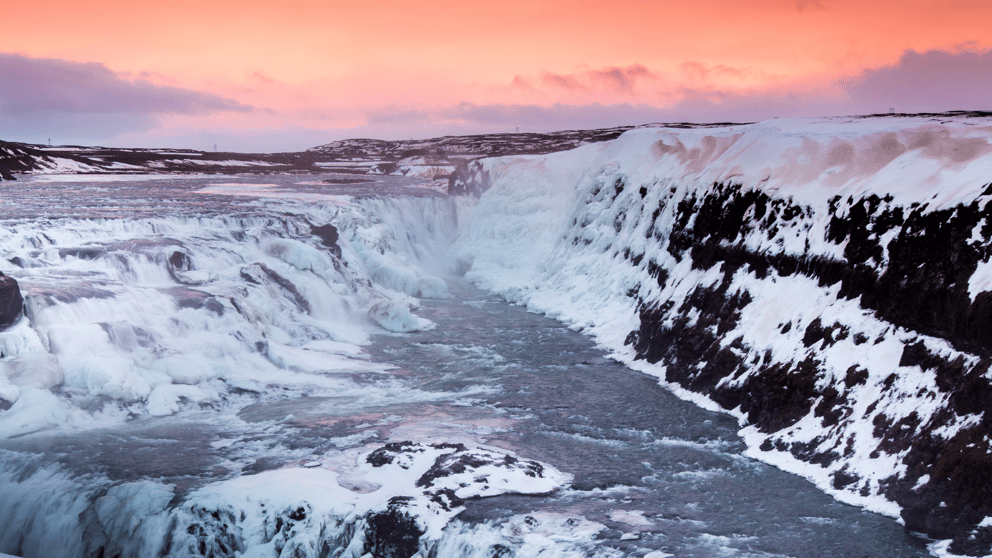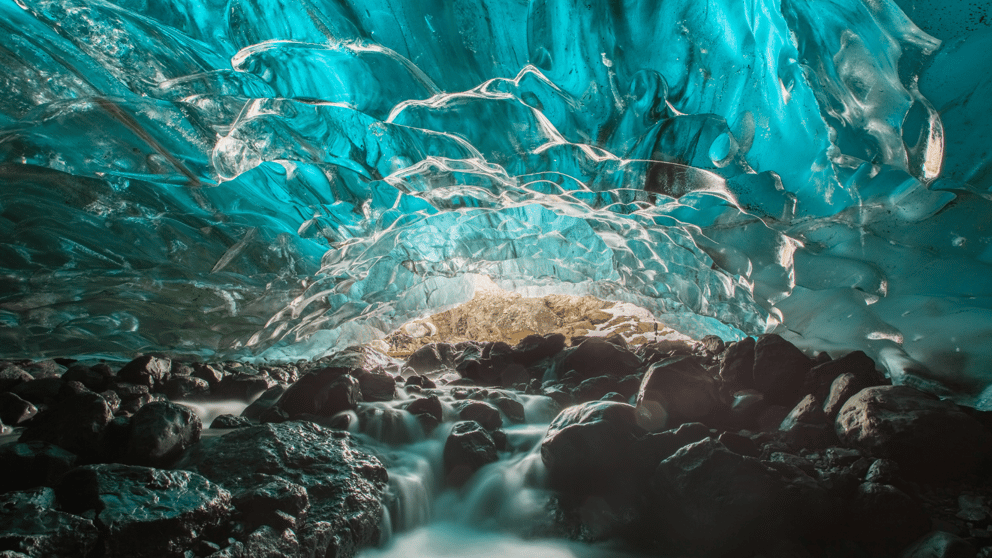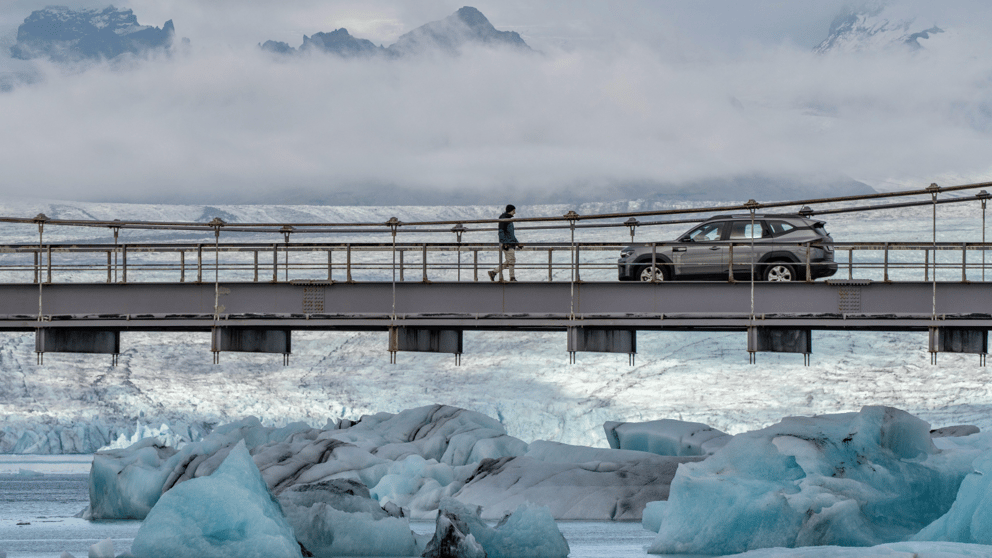Iceland in January
Iceland in January: Weather, Things to Do, and Travel Tips
January is one of Iceland’s coldest months, but also one of the most magical. Beautifully frosted snowy landscapes, icy waterfalls, and long nights lit by the Northern Lights make it a unique time to visit. In this guide, you’ll discover what Iceland in January is really like, from weather and temperatures to the best things to do and essential travel tips.
What is Iceland Like in January?
Visiting Iceland in January is like stepping into a real-life winter wonderland. The frozen, mystical atmosphere is completely different from the experience of visiting during the summer months. While daylight hours are limited, averaging between 4 and 7 hours depending on when in the month you visit, the low light creates incredible photo opportunities with soft golden skies during sunset and sunrise.
The long nights also offer excellent chances to see the Northern Lights, especially if you are able to escape the city and head into the countryside, where light pollution is low.
January is deep winter in Iceland, which means low temperatures, icy roads, and unpredictable weather. However, it also means fewer crowds, lower travel costs, and the chance to experience Iceland at its most raw and authentic during the low season.

Weather In Iceland in January
With temperatures averaging between 1° and -1° in Reykjavík, it can be pretty cold in Iceland in January, and when you factor in the bitter wind chill, it can feel significantly colder. January is also a wet month and has an average precipitation of 75 millimeters. Always be sure to check the weather forecast before planning a day out in Iceland, because January is known for its unpredictability, bringing snow, hail, and wind.
What to Pack for January Weather
If you’re planning your trip for this time of year, you’ll need to pack like a local to ensure you are prepared for the harsh weather! Important items to pack include:
- Thermal base layers
- Insulated waterproof jacket
- Waterproof hiking boots
- Hat, gloves, and scarf
Despite the cold, the dramatic winter weather only adds to Iceland’s charm. Just come prepared and you’ll be ready for anything!
Things to do in Iceland in January
Iceland in January is packed with unforgettable winter experiences. From natural wonders to seasonal adventures, this time of year offers a unique look into the country’s dramatic landscapes. Whether you’re chasing the Northern Lights or warming up in the geothermal pools, here are the top things to do in Iceland in January.

Explore Ice Caves
January is the perfect month to see the ice caves in Iceland. Ice caves are a natural phenomenon that are formed in glaciers and caused by running water. The sub-zero temperatures in January ensure minimal flooding and improve the ice cave structure. We highly recommend visiting the ice caves at Vatnajökull, Europe’s largest glacier, which covers roughly 8% of Iceland’s surface! The Crystal Ice Cave at Vatnajökull is most likely the most popular ice cave in Iceland. It is infamous for its bright blue colours and beautiful ice patterns. Other excellent ice caves worth a visit include the Katla Ice Cave and the Skaftafell Ice Caves.
Snorkel Between the Tectonic Plates
Although it may sound a little too cold for snorkelling in January, it is still considered the best month to see Iceland’s underwater magic, especially at Silfra. Silfra is where most snorkelling and diving tours take place, and it is known as one of the best places to dive in the world, due to its location between the North American and Eurasian tectonic plates. In January, it is a great idea to dive at Silfra due to the snow and ice sculptures that the cold January climate brings. You’ll be given all the equipment you need when you join a tour, including a dry suit to keep you warm! Always be sure to check conditions before your dive.
Chase the Northern Lights
In January, daylight is limited, with roughly 5 hours of daylight each day. Sunrise is typically around 11:00 AM, and sunset occurs at approximately 4:11 PM. While this might seem short, it brings the perfect opportunity to hunt the Northern Lights, as you will have more opportunities to catch them. Before planning a trip to see this natural phenomenon, always check the aurora forecast. This allows you to check the predicted aurora activity and cloud cover to avoid disappointment.
Spot Elusive Icelandic Wildlife
January can be a great time of year to go whale watching, despite it not being their peak season. Species such as humpbacks, minke whales, orcas, and harbor porpoises have been known to stay in Icelandic waters during the winter, particularly in the south. Looking out to the sea, you may also spot seals resting on icebergs, especially at Jökulsárlón Glacier Lagoon.
Other wildlife in January is often well hidden due to the harsh winter climate. However, it's sometimes possible to spot reindeer in the east of Iceland, as the herds move down to the lowlands in search of food. If you’re very lucky, you might also catch a glimpse of eagles in the Snæfellsnes Peninsula region, but sightings are rare.
If you’re looking to get closer to the wildlife in Iceland, Icelandic horseback riding is available all year round and is very popular with tourists. You will be able to see the beautiful frozen landscape as well as get closer to the wildlife Iceland offers.

Driving in Iceland in January
Taking a self-drive trip in Iceland is one of the best ways to explore the country’s winter beauty at your own pace. Driving in Iceland in January is incredible, but can be challenging due to the icy conditions, unpredictable snowfall, strong winds, and limited daylight.
The Ring Road, which offers access to many of Iceland’s most popular attractions, is well-maintained and regularly cleared, making driving here much simpler. Other roads, such as the F-Roads in the Highlands, are completely impassable and will be closed in January.
Renting a 4x4 is a good idea if you are visiting Iceland in January, as these vehicles are well-equipped to handle icy roads and unpredictable weather conditions. A 4x4 offers better traction, stability, and control on snow-covered surfaces, making it a safer and more comfortable choice for exploring Iceland’s frozen countryside.
Up-to-date road conditions can be found on umferdin.is/en, and weather conditions can be checked at vedur.is/. It is important to check these resources before heading out in the car.
Iceland in January FAQS
Planning your trip to Iceland in January? You’ll likely have lots of questions about the best experiences, what to bring, and how to stay safe. Below are answers to some of the most common questions that travelers have about visiting during this winter month.
What should I wear in Iceland in January?
The key to keeping warm during the winter months in Iceland is wearing appropriate layers. You’ll need a thermal base layer, an insulated jacket, waterproof outerwear, thick socks, gloves, a hat, and sturdy, waterproof boots.
Is January a good time to spot the Northern Lights in Iceland?
Yes, January is one of the best months to see the Northern Lights in Iceland. The long nights provide plenty of dark hours for hunting the aurora. Increase your chances further by heading away from the city lights.
Can you see puffins in Iceland in January?
Unfortunately not. Puffins are seabirds that spend the winter months out at sea, where they can rest and dive for fish. They typically only return to land in Iceland during breeding season, which is usually from April/May to August.
Does it snow in Iceland in January?
Yes, January is one of the snowiest months in Iceland, and snowfall is common across the country. You can expect to see snow on the ground and to experience snowfall frequently in most areas throughout the month.
Can I visit the Golden Circle in January?
Yes, the Golden Circle route is accessible year-round, which makes it an ideal road trip to take in January. The roads are paved and well-maintained, but it is still important to check weather conditions ahead of your journey to avoid any unexpected surprises.
What is the temperature in Iceland in January?
In January, temperatures typically range from 1°C to -1°C, but can drop as low as -15°C, particularly in the north and the east. You also need to be prepared for the wind chill, which can make it feel significantly colder.

